Are you ready to embark on a tropical taste adventure? Say hello to the spiky lychee-like fruits that are sure to tantalize your taste buds. These exotic fruits, with their rough skin and sweet flesh, are a delightful alternative to the traditional lychee. Prepare yourself for a burst of flavor and a touch of paradise as we explore these fascinating fruits and discover how to enjoy them.
Key Takeaways:
- Rambutan and other spiky lychee-like fruits offer a unique and tropical taste experience.
- They are often compared to lychees but have their own distinct flavors and textures.
- Rambutan, in particular, is a Malaysian fruit with a spiky exterior and sweet, jelly-like flesh.
- These fruits can be enjoyed fresh, used in various dishes, or explored for their potential uses beyond the plate.
- If you love rambutan, other similar fruits like pomelo, jackfruit, wax apples, and lychee are worth exploring.
Rambutan – The Lychee Cousin with Spikes
Rambutan, a tropical fruit native to Malaysia, is a close relative of the lychee. It has a spiky exterior, covered in hair-like bristles, which gives it its name, derived from the Malay word for ‘hair.’ The juicy, sweet flesh of the rambutan is similar to that of a lychee, with a soft jelly-like texture. It is often enjoyed fresh but can also be used in various dishes, such as jams and curries. Rambutans are rich in vitamin C and are a healthy snack option. They are available fresh or canned in syrup and can be found in grocery stores and Asian markets.
Do you know?
Rambutan has been cultivated in Malaysia since the 13th century and is considered one of the most important fruits in the region.
| Nutritional Information per 100g | |
|---|---|
| Calories | 68 kcal |
| Fat | 0.3g |
| Carbohydrates | 16.5g |
| Fiber | 0.9g |
| Sugar | 13.7g |
| Protein | 0.9g |
| Vitamin C | 20.9mg (35% DV) |
How to Prepare and Eat Rambutan
Peeling and eating rambutans may seem intimidating at first due to their spiky exterior, but it’s actually quite simple. To prepare a rambutan, give it a quick rinse under the tap. Use a paring knife to carefully slice through the peel, being careful not to cut into the flesh. Once the peel is sliced around the fruit, it can be easily peeled away to reveal the white flesh inside. Rambutans have a single seed in the center, which can be removed by hand. The flesh has a sweet and floral flavor, similar to grapes, making it a delicious tropical treat.
“Peeling and eating rambutans is a delightful experience. Their vibrant colors and soft, juicy flesh make them a perfect snack for any occasion. The trick is to slice through the spiky exterior with precision, revealing the luscious fruit within. Once you taste the sweet and floral flavor of rambutan, you’ll be hooked!”
The Nutritional Benefits of Rambutan
When it comes to rambutan, not only is it a delicious fruit, but it also offers several nutritional benefits. This exotic tropical fruit is packed with essential nutrients that promote overall health and well-being.
Vitamin C for Immunity Boost
One of the standout nutritional qualities of rambutan is its high vitamin C content. Just 3.5 ounces (100g) of rambutan contains approximately 59mg of vitamin C, which is more than half of the recommended daily intake for adults. Vitamin C is a potent antioxidant that helps strengthen the immune system, protect against free radicals, and support collagen formation for healthy skin and joints.
Soluble Fiber for Digestive Health
In addition to vitamin C, rambutan is also a good source of soluble fiber. Soluble fiber plays a crucial role in maintaining a healthy digestive system. It helps regulate bowel movements, prevents constipation, and promotes the growth of beneficial gut bacteria. Including rambutan in your diet can contribute to optimal digestive health and overall well-being.
Copper for Essential Functions
Rambutan is also rich in copper, an essential mineral that is necessary for various bodily functions. Copper plays a vital role in the production of red blood cells, aids in the absorption of iron, supports collagen synthesis, and helps maintain a healthy nervous system. Incorporating rambutan into your diet can help ensure you’re meeting your recommended copper intake.
Rambutan flesh is low in calories, with 3.5 ounces (100g) containing around 75 calories. This makes rambutan a guilt-free and healthy snack option that can be enjoyed as part of a well-balanced diet.
To summarize, rambutan offers not only a unique and tropical taste experience but also numerous nutritional benefits. Its high vitamin C content, coupled with soluble fiber and copper, makes rambutan a valuable addition to a healthy diet. So, the next time you crave a sweet and healthy snack, reach for some delicious rambutan!
| Nutrient | Amount per 3.5 oz (100g) |
|---|---|
| Vitamin C | 59mg |
| Soluble Fiber | 1.9g |
| Copper | 0.02mg |
| Calories | 75 |
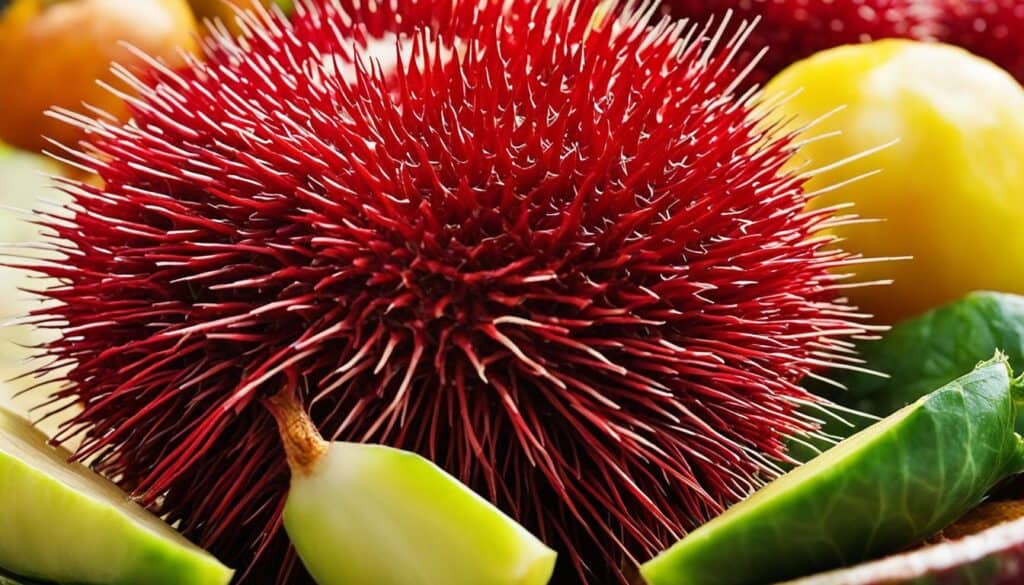
Note: Nutrient values may vary depending on the ripeness and size of the fruit.
Rambutan’s Uses Beyond the Plate
Besides being a tasty fruit, rambutan has potential uses beyond the plate. Studies have shown that rambutan extract possesses antioxidant properties, making it valuable in non-food applications. One notable application is its use as a sunscreen additive, where its antioxidant properties can help provide protection against harmful UV rays. Rambutan extract serves as a low-cost additive, making it an attractive alternative for sunscreen manufacturers seeking natural ingredients.
Rambutan seeds also offer an interesting potential application. The fat extracted from rambutan seeds is being explored as an alternative edible fat. This presents an opportunity for the development of healthier, plant-based alternatives to traditional fats. Further research is being conducted to fully understand the viability and potential benefits of rambutan seed fat as an alternative in culinary applications.
Rambutan waste, such as the peel and other by-products, is being investigated for its potential in the production of renewable biofuel. Specifically, rambutan waste can be used to create biomass briquettes that can be used as fuel for electricity generation and cooking. This not only offers a sustainable solution for waste management but also contributes to the development of renewable energy sources.
Furthermore, rambutan cultivation holds economic value beyond the fruit itself. By promoting rambutan cultivation, communities can generate additional income and improve their resilience to climate change. This tropical fruit presents an opportunity for farmers to diversify their crops and tap into a market driven by its growing popularity both domestically and internationally.
Similar Fruits to Explore
If you enjoy rambutan, you may want to explore other fruits with unique flavors and textures. Here are some delightful options to satisfy your taste buds:
Pomelo
Pomelo is a tropical fruit that is sweeter and milder than a grapefruit. It has a thick rind and juicy flesh that is rich in vitamin C. The refreshing taste of pomelo makes it a perfect addition to fruit salads or enjoyed on its own.
Jackfruit
Jackfruit is the largest fruit in the world and is known for its impressive size and versatility. Its starchy and fibrous flesh has a unique flavor that blends apple, mango, pineapple, and banana. Jackfruit can be used in both sweet and savory dishes, making it a must-try for adventurous eaters.
Wax Apples
Wax apples, also known as rose apples, have a delicate pear-like flavor. They are often used in salads or lightly sautéed to maintain their crisp texture. Wax apples are a refreshing and low-calorie fruit option.
Lychee
Lychee, the popular Chinese fruit, has a similar appearance to rambutan with its bumpy skin. It has a more crisp and sweet flesh that is highly addictive. Lychees are often enjoyed fresh or used in desserts and cocktails.
Explore these fantastic fruits and discover new flavors that will enhance your culinary experience. Each of these fruits offers its own unique taste and can be enjoyed in various dishes and preparations.
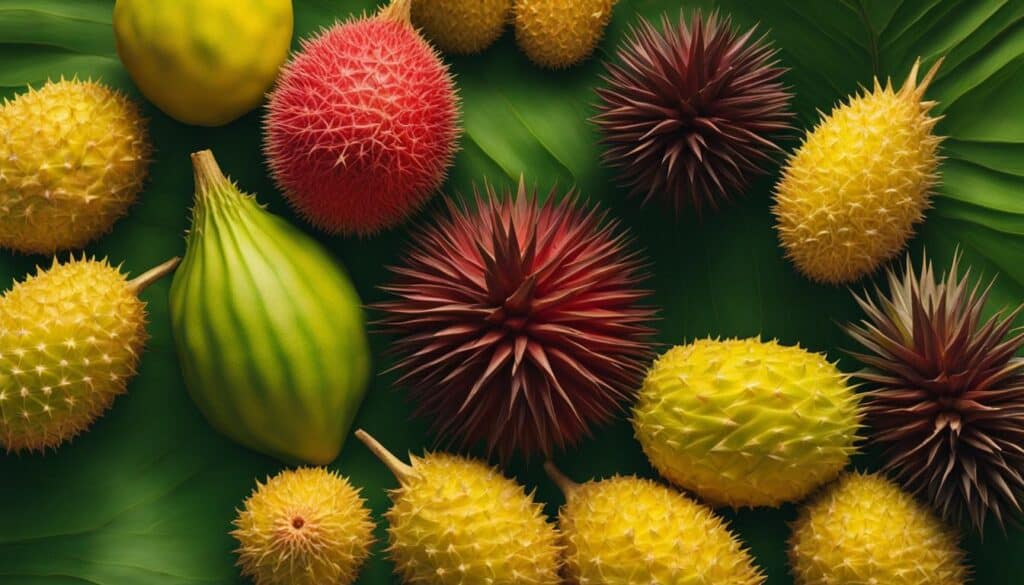
| Fruit | Flavor | Uses |
|---|---|---|
| Pomelo | Sweeter and milder than grapefruit | Fruit salads, desserts |
| Jackfruit | Combination of apple, mango, pineapple, and banana | Sweet and savory dishes |
| Wax Apples | Pear-like flavor | Salads, sautéed |
| Lychee | Crisp and sweet flesh | Desserts, cocktails |
How to Enjoy These Delicious Fruits
These spiky lychee-like fruits offer a plethora of delicious possibilities. From tempting desserts to refreshing cocktails, the versatility of these fruits knows no bounds. Let’s explore some delightful ways to savor these tropical treasures:
Fruit Recipes
Get creative with these exotic fruits by incorporating them into various fruit recipes. Whether you’re making a vibrant fruit salsa, a refreshing fruit kebab, or a tropical fruit tart, these spiky lychee-like fruits will add a burst of flavor and a touch of elegance to any dish.
Fruit Desserts
Treat yourself to mouthwatering fruit desserts featuring these delightful fruits. From creamy rambutan ice cream to decadent lychee mousse, there’s no shortage of sweet treats to satisfy your cravings. Create a heavenly fruit parfait or indulge in a fruity pavlova, and let these fruits take center stage.
Fruit Salads
Add a tropical twist to your salads by incorporating these spiky lychee-like fruits. Their juicy texture and sweet taste make them a perfect addition to any fruit salad. Combine them with other tropical fruits like pineapple, mango, and papaya for a refreshing and vibrant flavor combination.
Tropical Cocktails
Unleash your inner mixologist and create tantalizing tropical cocktails with these fruits. Whether you’re concocting a refreshing rambutan mojito, a tangy lychee margarita, or a tropical fruit punch, these fruits will elevate your beverage game and transport you to a blissful paradise.
Curries
Embrace the exotic flavors of these fruits by incorporating them into savory curries. The unique sweetness of these fruits pairs wonderfully with aromatic spices, creating a harmonious balance of flavors. Try adding rambutan or lychee to a Thai curry or a Malaysian rendang for a delightful twist.
Fruit Jams
Capture the essence of these tropical fruits by making flavorful fruit jams. The natural sweetness and unique flavors of these fruits make them ideal for jams. Spread them on toast, use them as cake fillings, or dollop them onto scones for a taste sensation that will brighten your mornings.
No matter how you choose to enjoy these spiky lychee-like fruits, their vibrant flavors and exotic profiles are sure to impress. Let your culinary creativity run wild and explore the endless possibilities these fruits have to offer.
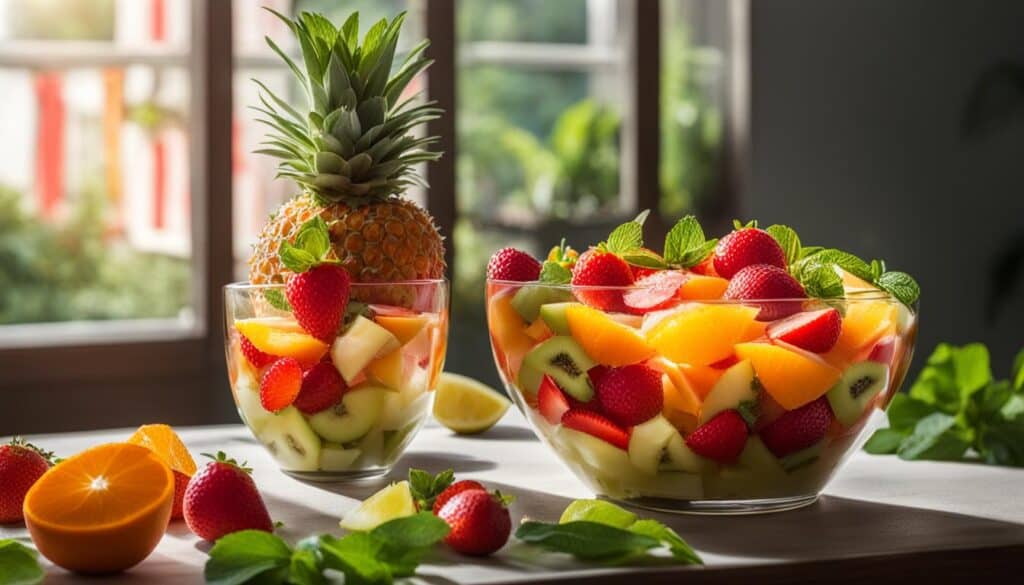
Where to Find and Store Rambutan
If you’re eager to try rambutan, you can find them in various locations:
- Grocery stores
- Asian markets
- Nationwide chains
Rambutans are available both fresh and canned in syrup. For the freshest rambutans, look for dark reddish-brown fruits, as paler ones may not be fully ripe. Fresh rambutans are most plentiful in August and September.
To ensure optimal freshness, store fresh rambutans unpeeled in the refrigerator. They should be consumed within a week. To retain moisture, wrap them in a paper towel and place them in a perforated plastic bag or breathable container.
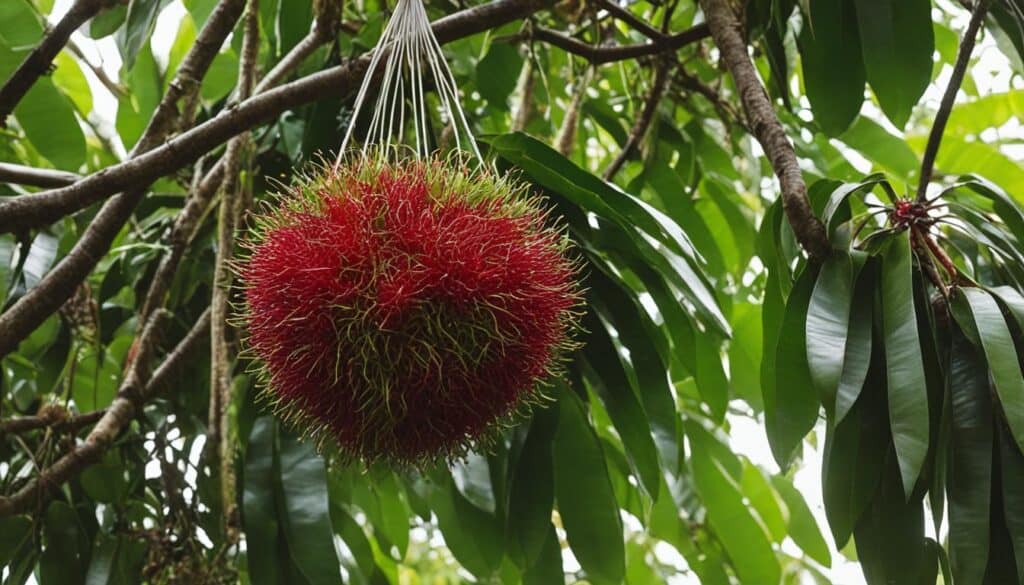
| Where to find rambutan: | Availability: |
|---|---|
| Grocery stores | Available |
| Asian markets | Available |
| Nationwide chains | Available |
| Fresh rambutans | Most plentiful in August and September |
Source: Personal experience
Conclusion
In conclusion, the spiky lychee-like fruits, such as rambutan, offer a delightful tropical taste experience that is sure to tantalize your taste buds. With their unique appearance and sweet, juicy flesh, they are a perfect addition to any tropical fruit lover’s repertoire.
Rambutan and other spiky lychee-like fruits provide a burst of flavor and a touch of tropical paradise to any dish or snack. Whether enjoyed fresh, added to recipes, or explored in creative ways, these fruits are a true tropical treasure.
So, indulge in the exotic delicacy of rambutan and other spiky lychee-like fruits and embark on a fruity adventure that will transport you to the sunny shores of a tropical island. Their delectable taste, vibrant colors, and refreshing qualities will leave a lasting impression and make you crave for more. Don’t miss out on experiencing these fascinating fruits for yourself!
FAQ
What is rambutan?
Rambutan is a tropical fruit that belongs to the soapberry family. It has a spiky exterior and sweet, juicy flesh similar to lychee.
How do I prepare and eat rambutan?
To prepare rambutan, rinse it under water and use a paring knife to slice through the peel. Peel away the spiky skin to reveal the white flesh inside. Remove the seed and enjoy the sweet and floral flavor.
What are the nutritional benefits of rambutan?
Rambutan is rich in vitamin C, fiber, and copper. It is also low in calories, making it a healthy snack option.
What are some uses of rambutan beyond eating?
Rambutan extract can be used as an additive in sunscreens, and the fat from rambutan seeds is being explored as an edible alternative. Rambutan waste can also be used as a renewable biofuel.
Are there other fruits similar to rambutan?
Yes, there are fruits like pomelo, jackfruit, wax apples, and lychee that offer unique flavors and textures.
How can these fruits be enjoyed?
These fruits can be used as garnishes, juiced, blended into smoothies, added to desserts, salads, cocktails, curries, or cooked down to make fruit jams.
Where can I find and store rambutan?
Rambutan can be found in grocery stores, Asian markets, and some nationwide chains. Look for dark reddish-brown fruits, store them unpeeled in the refrigerator, and consume them within a week.

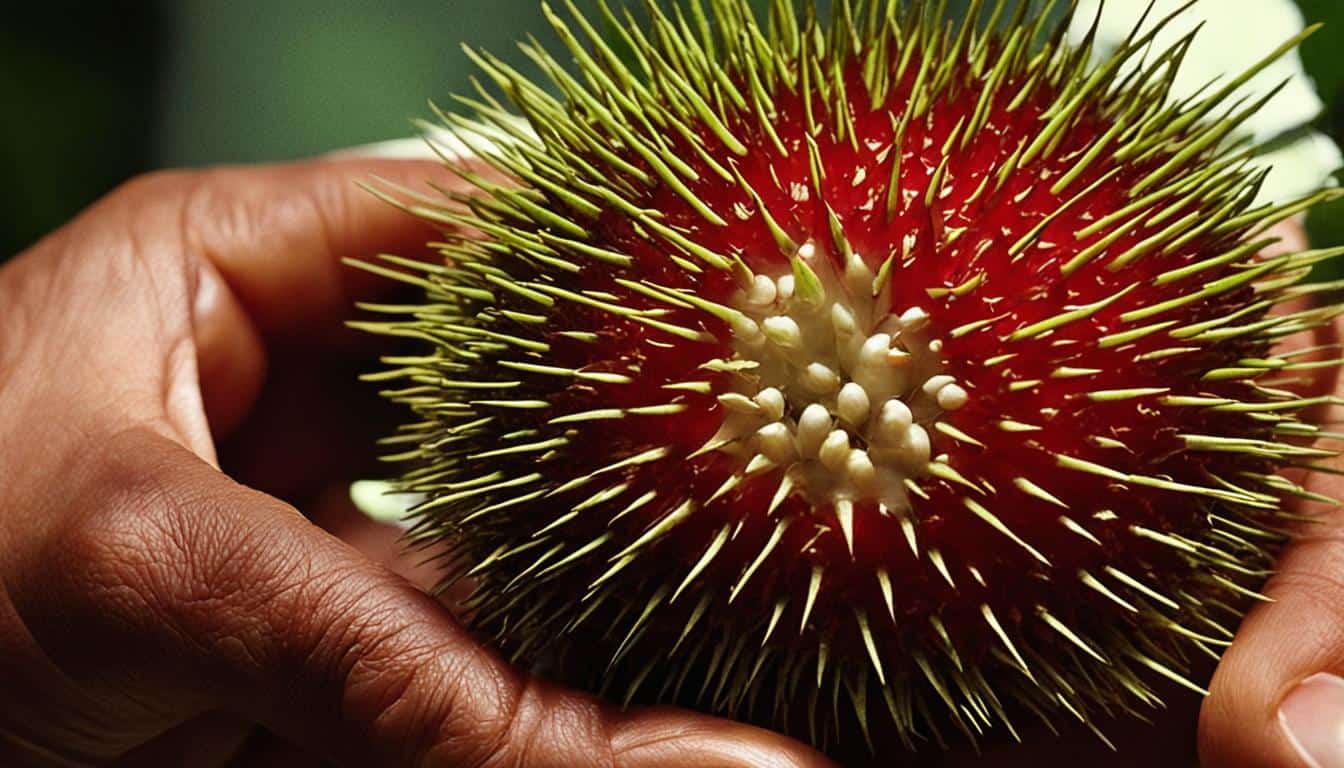



Leave a Reply